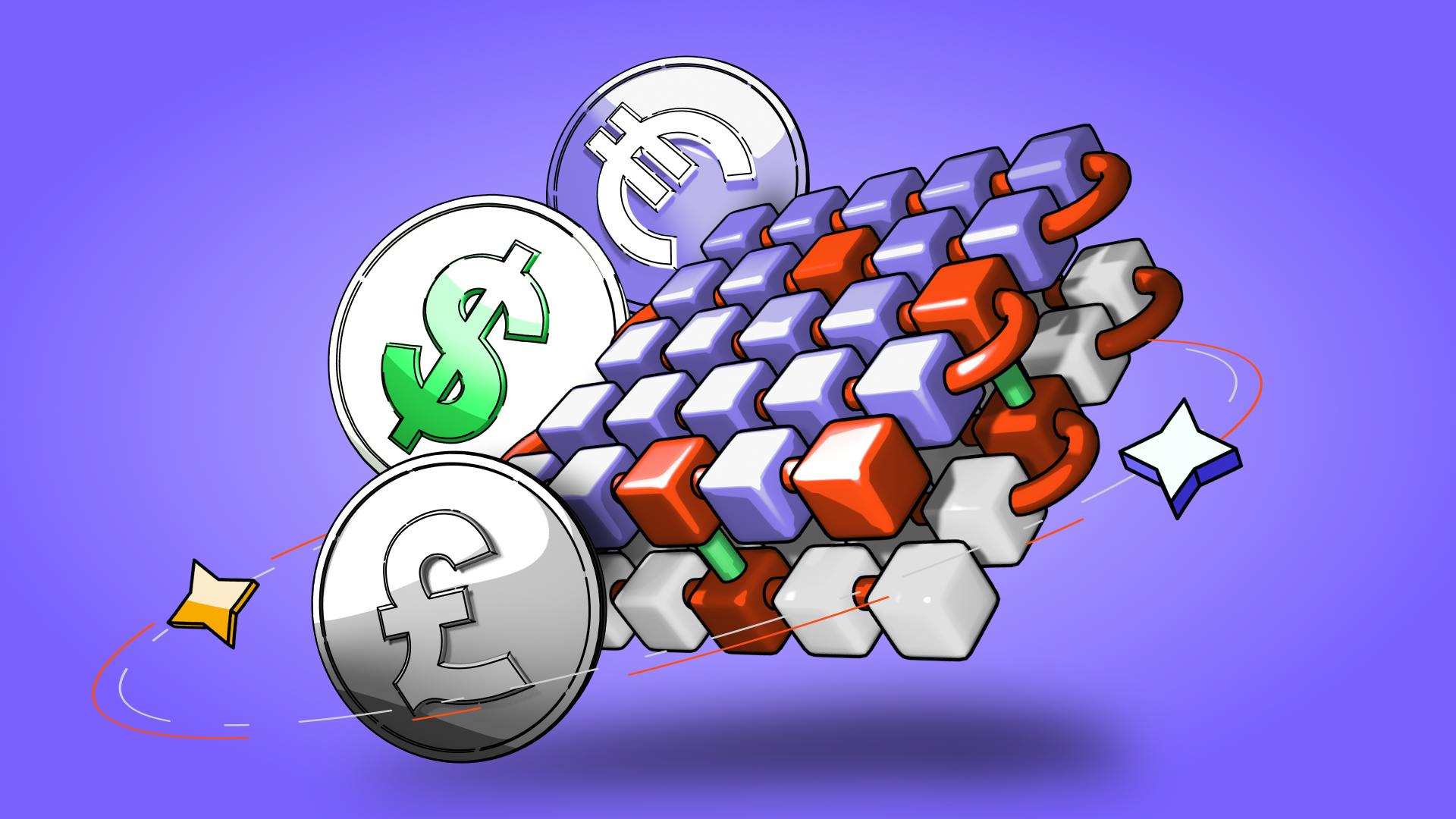Algorithmic Stablecoins: Innovations and Challenges
December 5, 2025

by Coinmetro Editorial Team
December 5, 2025
Algorithmic stablecoins are digital currencies designed to maintain a stable value over time, often pegged to traditional assets like the US dollar or gold, or to a basket of multiple crypto assets. Unlike widely-used fiat-collateralized stablecoins, which rely solely on asset reserves for stability, these utilize algorithms and smart contracts for automatic supply adjustments based on demand, among other stabilizing features. This positions them as an intriguing component of the cryptocurrency market, aiming to provide the advantages of digital currency while seeking to manage the volatility commonly associated with cryptocurrencies. However, their stability varies, with each experiencing its own level of volatility influenced by market conditions and the effectiveness of their stabilization mechanisms.
Unlike algorithmic stablecoins, which mainly rely on algorithms to maintain their value, the more popular fiat-collateralized stablecoins are backed by actual reserves of fiat currency. This means for every stablecoin issued, there is a corresponding unit of currency (like the US dollar) held in reserve. Examples include USDT (Tether) and USDC (USD Coin), where each coin is pegged to and backed by one US dollar, ensuring their value remains stable and consistent with the fiat currency they're tied to.
The core function of algorithmic stablecoins is to maintain a stable value, usually pegged to a fiat currency or a basket of assets. One way this is achieved is through an algorithmic approach that automatically adjusts the coin's supply in response to changes in demand. If the price of the stablecoin rises above the peg, the algorithm increases supply to lower the price. Conversely, if the price falls below the peg, the algorithm decreases supply, pushing the price up. This dynamic adjustment helps keep the stablecoin's value consistent.
Beyond these basic mechanisms, there exist more complex algorithms designed to tackle the multifaceted challenges of market volatility and regulatory compliance, further securing the stability and reliability of these digital currencies.
Several key technologies and concepts are fundamental to the operation of algorithmic stablecoins:
Smart contracts: These are self-executing contracts with the terms of the agreement directly written into lines of code. They play a crucial role in managing the supply of stablecoins based on pre-defined rules.
Collateralization: While traditional stablecoins are backed by reserves of fiat currency or assets, algorithmic stablecoins use a form of collateralization that may involve other cryptocurrencies or mechanisms to maintain their peg.
Seigniorage-style models: This approach involves creating and destroying the stablecoin to maintain its value. Profits generated through this process, known as seigniorage, are used to fund the system and ensure its sustainability.
Innovations in the algorithmic stablecoin sector are unfolding fast, fueled by technological breakthroughs aimed at bolstering both the stability and utility of these digital currencies. This evolution marks a significant shift towards developing more sophisticated mechanisms and infrastructures that promise to redefine digital finance. Below, we explore specific technological advancements and highlight several stablecoins that exemplify this dynamic progression.
Advanced Supply Adjustment Mechanisms: One big leap is in how these stablecoins adjust their supply. Advanced algorithms now use data from multiple sources to decide faster when to create or burn coins. This aims to potentially keep their value stable even in highly volatile markets.
The Evolution of Smart Contracts: The digital protocols that facilitate, verify, or enforce the negotiation or performance of a contract in blockchain technology, have significantly evolved. Initially, these contracts executed simple operations, like sending cryptocurrency from one user to another under specific conditions. However, advancements in blockchain technology have enabled smart contracts to execute more sophisticated functions, enhancing both the security and functionality of algorithmic stablecoins.
For example, the DAI stablecoin operates on the MakerDAO protocol, utilizing smart contracts to maintain its peg to the US dollar. These contracts automatically manage the DAI supply, increasing or decreasing it in response to market changes. They also handle collateralization, ensuring that each DAI is backed by excess collateral in the form of other cryptocurrencies, thus adding an extra layer of security and trust.
Efficient Blockchain Scaling: Another important change is the use of blockchain technology that can handle more transactions at once. This means stablecoins can be used by more people and for more kinds of payments, without slowing down.
Frax (FRAX): Fractional-algorithmic mechanism
Frax (FRAX) is an innovative example in the algorithmic stablecoin space that has garnered attention for its unique approach to maintaining stability. Unlike traditional models, Frax is the first stablecoin system to implement a fractional-algorithmic mechanism. This means part of its value is backed by collateral, like USDC, while the rest is stabilized through algorithmic means. The ratio of collateralized to algorithmic depends on the market's confidence in FRAX, allowing it to adjust dynamically to demand changes. This hybrid model seeks to combine the best of both worlds: the reliability of collateral-backed stablecoins and the flexibility of algorithmic stablecoins. It represents a thoughtful approach to addressing the volatility and trust issues that have challenged purely algorithmic stablecoins.
Ampleforth (AMPL): Rebasing mechanism explained
Ampleforth (AMPL) is unique because it changes the number of tokens in users' wallets directly to adjust supply. This method, called "rebasing," aims to keep AMPL's price close to a dollar, but it means the number of AMPL tokens you have can change daily, based on the current exchange rate and demand. However, this novel approach to value and volatility maintains a user's market share of the total cap, despite daily changes in token quantity.
Opinions on AMPL's success are mixed. Some praise its innovative stabilization strategy within DeFi, while others caution against the unpredictability of fluctuating token quantities. Despite its aim to stabilize purchasing power, Ampleforth (AMPL) faces volatility due to market reactions to its unique daily supply adjustments and broader sector perceptions.
MakerDAO (DAI): Collateralized debt positions (CDPs)
As previously mentioned, DAI is a decentralized, collateral-backed cryptocurrency soft-pegged to the US Dollar. Operated on the Ethereum blockchain through the MakerDAO system, DAI maintains its peg through a dynamic system of Collateralized Debt Positions (CDPs), supported by a diversified collateral pool including Ethereum (ETH), Basic Attention Token (BAT), and USDC, among others. Furthermore, the value is leveraged through autonomous feedback mechanisms, and appropriately incentivized external actors. This complex system ensures that DAI remains closely tethered to the value of the US dollar, showcasing a successful integration of collateral backing with algorithmic governance.
Algorithmic stablecoins aim for stability, but they often face significant price swings. These fluctuations can result from abrupt shifts in market demand or broader changes in the cryptocurrency landscape, significantly affecting the stablecoin's collateralization levels and its underlying algorithms. For example, if a lot of people decide to sell an algorithmic stablecoin at once, it might lose value quickly before the algorithm can adjust the supply. This kind of volatility can make people hesitant to use them for daily transactions or as a store of value.
On the regulatory front, governments and financial authorities are still figuring out how to handle these digital currencies. Some countries have strict rules about financial products and services, which can include stablecoins. The unique nature of algorithmic stablecoins, with their automated supply adjustments and lack of physical backing, can make it even more challenging for regulators to apply existing laws or create new ones that fit.
Trust is vital for any currency, digital or otherwise. For algorithmic stablecoins, earning and keeping that trust is challenging. Since these stablecoins are relatively new and use complex mechanisms to maintain their value, people and businesses might be cautious about adopting them. They may prefer more traditional, collateral-backed stablecoins or other digital currencies they feel are more reliable.
Adoption by the broader financial ecosystem is another challenge. For algorithmic stablecoins to become widely used, they need to be accepted by a range of businesses, from small shops to large online retailers, and even financial institutions. However, due to their volatility and the uncertainties around regulation, many of these potential users are waiting on the sidelines. They may also have concerns about the technical aspects of integrating algorithmic stablecoins into their existing payment systems and the potential for regulatory changes that could affect their use.
Together, these challenges highlight the need for continued innovation in the design and regulation of algorithmic stablecoins. They also underscore the importance of building trust with users and the broader financial ecosystem to ensure these digital currencies can reach their full potential.
Algorithmic stablecoins hold significant potential in the expanding world of decentralized finance (DeFi) and the broader financial ecosystem. As DeFi platforms continue to grow, offering lending, borrowing, and trading services without traditional intermediaries, algorithmic stablecoins could provide a stable medium of exchange and value storage, essential for the ecosystem's functioning. Their ability to maintain value stability through algorithms rather than physical reserves could lead to more scalable and flexible financial solutions.
However, the journey ahead is not without its challenges. Regulatory changes pose a significant threat to the adoption and functioning of algorithmic stablecoins. Worldwide, governments and financial regulators are scrutinizing the stablecoin market closely, with potential regulations on the horizon that could affect the operation and usage of these digital currencies. The specifics of such regulations remain uncertain, but they could include requirements for increased transparency, stability mechanisms, or even limitations on their use.
Market acceptance is another critical factor that will determine the future of algorithmic stablecoins. For widespread adoption, these stablecoins must gain the trust of users, businesses, and regulators alike. This trust hinges on their ability to consistently maintain their peg in various market conditions, the resilience of their underlying algorithms, and their capacity to withstand financial shocks.
While algorithmic stablecoins present a promising avenue for innovation in digital finance, their future is intricately linked to navigating regulatory landscapes and winning market confidence. As the sector evolves, the ability of these stablecoins to address these challenges will be essential in realizing their potential and shaping their role in the future financial system.
Join the Coinmetro community on Discord and Telegram, where forward-thinking traders and investors gather to share insights, explore new opportunities, and dive deep into the world of cryptocurrencies. Should you need any help, feel free to reach out to our world-class Customer Support Team via 24/7 live chat or email at hello@coinmetro.com.
To become a Coinmetro user today, Sign Up now, or head to our new Exchange if you are already registered and experience our premium trading platform.
Tags
Related Articles

Regulatory Sandboxes: Fostering Crypto Innovation Within Legal Frameworks
The cryptocurrency industry’s fast rise fuels an important debate. Innovation aims to transform finance, enhancing speed and access. Yet, regulators…
5m

Crypto Options Trading: Strategies and Market Insights
Cryptocurrency markets have rapidly expanded beyond simple buying and selling. One of the most significant developments has been the rise of…
6m

The Rise of Social-Fi: Blending Social Media with Decentralized Finance
In recent years, social media and finance have started to merge, creating Social-Fi. This concept blends the engagement of social platforms with…
6m

DeFi Insurance Platforms to Watch in 2024
Decentralized Finance (DeFi) insurance addresses the growing need for insurance against hacks, smart contract failures, and other DeFi-related risks.…
7m